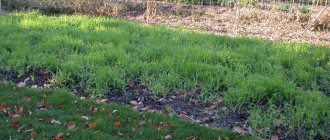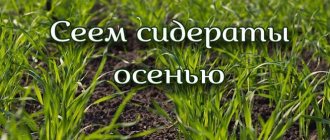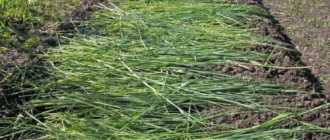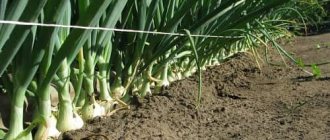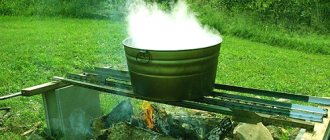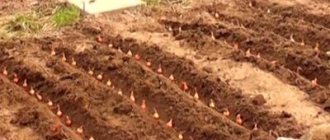Green manures, or green fertilizers, are extremely popular as autumn-winter crops. They are valued for their ability to reduce the effects of soil erosion from winter rains, promote aeration and improve heavy clay soils, suppress weeds and provide habitat for ground beetles, frogs and other beneficial predators. At the beginning of a new growing season, dug up green manure will help improve the fertility and structure of the soil.
- Why sow green manure before winter?
- How to choose green manure for a greenhouse
- What green manures can be sown before winter
- When can you sow winter green manures?
- How to sow green manure before winter
- What to do with green manure after winter
Why sow green manure before winter?
Typically, green manure is sown in the fall to prevent winter rains from leaching nutrients from the soil and to give green manure enough time to develop its root system to improve heavy soils and prepare in advance for spring planting.
When sowing in clay soil, adding green fertilizers before winter helps improve the soil structure.
Plus, green manure provides some winter cover for frogs, beetles and other natural predators that feed on pests such as snails and slugs.
Botanical features
Rye has a fibrous root system that penetrates to a depth of two meters and can grow quite easily on sandy soils. High physiological activity allows crops to absorb useful elements from the soil, represented by poorly soluble compounds, in the shortest possible time.
The hollow stem part of rye has five to six internodes. The stem is straight, bare along almost the entire length, except for the area directly under the ears. The average height of the stem, depending on the varietal characteristics, can be about 0.8-1.0 m. The leaves are broad-linear, flat, up to 30 cm long and 25 mm wide. At the base of the leaf blade there is a shortened tongue with short bare or pubescent ears covering the stem part.
How to choose green manure for a greenhouse
You need to know what type of soil you have. Certain green manures are only used on specific soils, and if you want maximum benefit, you need to match the green manure to your soil. For example, lupins will be used in acidic soils, while alfalfa is not suitable for acidic soil, but likes dry, neutral soil.
Some green manures, such as rye, are suitable for most soils and will act solely as a soil improver by increasing organic matter.
Care measures
At the beginning of their growth, green manure in the garden needs watering, but only if there has been no rain for a long time and the soil has dried out. Watering must be taken responsibly, especially in arid regions. If at the beginning of growth the plants feel a lack of moisture, they will not be able to get much greenery. Once their roots have grown sufficiently long, they will no longer need to be watered. There is no need to fertilize cereal plants with anything, but you can add fertilizers to the soil before planting, for example, nitroammophoska in the amount of 20 g per 1 sq. m. m.
What green manures can be sown before winter
Before winter in the greenhouse you can sow: ryegrass, Hungarian vetch, rye (Secale cereale), phacelia, white mustard (Sinapis alba) (if you do not plan to sow cabbage in this place), garden beans (Vicia faba), peas (Vicia sativa ), winter vetch (Vicia villosa). The success of this enterprise depends on specific climatic conditions. In the Moscow region, legumes such as winter beans, feed peas and vetch are sown at the end of the season; mustard and rye.
It is important to note that legumes only absorb nitrogen when soil temperatures are above 8°C, so they may be less effective when planted before winter. But legumes are easy to grow, so using them as an overwinter crop to improve soil structure usually does not cause problems.
Mustard is excellent at suppressing weeds because it forms a dense leaf growth very soon after sowing. Mustard is not frost-resistant, so it will die after severe frosts. But don't worry, because in the spring this will allow you to easily incorporate the remaining leaves into the soil.
Landing rules
You need to decide when to sow green manure before winter in mid-July. After all, some of them are sown in August.
The time of sowing depends on the region - in the southern regions it can be postponed to a later period - to September, or even the first half of October. In the northern regions, night frosts sometimes even occur at the end of August.
Already at this time, the first steps are taken to plan plantings for the next year - this determines which green manure crops to sow and where to sow now. Plants planted in August should have time to grow 20-30 cm before the onset of cold weather, then they are cut off. But whether it is necessary to dig up the ground after this is a question at your discretion. You don’t have to do this; it’s better to leave them lying on the ground. The grass mowed in this way will cover the ground and protect it from frost. And in the spring it will also protect her from unexpected frosts at the beginning of seasonal work.
Winter green manures begin to be planted immediately after harvest. You can start as early as September, and if the summer is cold, then in August. If the August plantings germinate, the green cover should be cut off and left on the surface, and new green manure should be sown - they will become winter crops. Cut greens will become additional fertilizer when they rot.
Should I plant them in the fall?
Autumn sowing of green manure is often very useful.
- Saves time in the spring. There is no need to plant green manure at the hottest time and wait until it grows, then mow it and plant early vegetables in its place. It is already in the ground and is already sprouting.
- Moisten the soil. Green manure retains snow and moisture longer, and the ground has time to become saturated with it.
- Stay in the soil longer. Autumn planting of green manure extends the time they remain in the soil until almost mid-spring. Their root system loosens it, releases additional minerals, and saturates it with oxygen. All this will then be necessary for growing later crops.
- Protect from sun and frost. Cut green manure remains on the surface of the ground, covering it and serving as a kind of blanket for it. You can dig up the area as soon as stable heat sets in, and start sowing 2-3 weeks after digging.
How to sow
There are several basic rules.
- The area chosen for green manure must be properly cleared of the remnants of the harvested crop. Particular care must be taken to remove diseased and damaged remains of tops, weeds and remnants of previous plantings.
- They are sown in areas where crops are to be grown in the future.
- Before planting green manure, potassium-phosphorus fertilizers are applied to heavily depleted soil.
- Dried soil must be properly moistened; then you can sow in 2-3 days. When moistening, the soil must be dug to a depth of 5-10 cm, loosened well and then you can water it.
- No furrows are made for winter green manure. The seeds are evenly distributed over the prepared area, but not covered with soil, but covered with a rake and covered with a small layer of compost. If you make furrows, they should be shallow - 2-3 cm. You should sow very densely; in this case, the plants are not expected to produce a harvest.
With the onset of spring, green manure begins to grow rapidly. When they grow to a height of 20-25 cm, they are cut off and left on the surface of the earth. This creates a layer of mulch, under which the remaining roots quickly rot. Before planting the main crop, the soil with rotted green manure will need to be dug up.
Plants that sprouted in the fall are not touched; they are left to stand until spring. Winter species will remain green and will withstand frost well.
The main crop is sown a month after mowing the green manure.
Is it necessary to dig up green manure in the fall? This is completely optional. Grown green manure plants create dense protection on the surface of the earth, and with the onset of cold weather their growth completely stops. They will begin to grow again in the spring. That's when they will need to be mowed down.
What to do with green manure after winter
Overwintered crops can be buried in the spring 4-5 weeks before soil is needed for new plantings. Prune the plants and allow the foliage to wilt, then chop up the foliage with a shovel. Green manures should be cut before flowering, when the stems are soft, as they decompose more quickly, retain more beneficial nutrients, and are easier to incorporate into the soil. They can be buried in the soil or left on top as mulch, the worms will drag the organic matter down and help aerate the soil.
Be aware that green manure may produce chemicals that prevent seeds from germinating. Four to six weeks should elapse between digging the green manure and sowing the seeds.
You will find more tips on growing green manure here >>>>
The benefits of green organics
Sideration is the process of fertilizing the soil with plants. For more than 100 years, agronomists have been using green manure as a source of nutrition and soil restoration on large plots of land and small farms.
Historical fact . The method of enriching the earth with green fertilizers has been known since ancient times. In Central and Middle Asia it was used 3 thousand years ago. Since the 19th century, green manure has become popular in Europe.
Green manures are natural organic matter, green fertilizers that ensure the natural circulation and exchange of useful substances in the soil. The main advantage is environmental friendliness and safety for the environment.
World agronomic practice and science have proven that natural fertilizers increase soil fertility by 3-5 times. In addition, these are “long-range” fertilizers, a kind of advance payment for the future. They create favorable conditions for the growth and development of subsequent planting of plants (vegetables, root crops, berries).
Benefits of green organics:
- stimulates the development of soil organisms (worms, larvae, microorganisms);
- the roots of green manure plants optimize the mechanical structure of the soil, form a system of bark canals that accumulate nitrogen, starch, proteins, sugar and microelements;
- plant residues - natural mulch and compost, protecting the soil from weathering, blowing away and erosion;
- mulch from the mowed above-ground part prevents excessive growth of weeds (weed seeds remain without access to sunlight and do not germinate);
- green mulch protects the soil from drying out (gradually rotting fertilizer stems ensure uniform nutrition and hydration);
- a laying layer of winter green manure prevents soil damage by wind erosion; the fertile layer is protected from being washed away along the slope of the site.
Planting winter rye on the plot - video
Rye is a green manure that perfectly loosens and enriches the soil. It can be planted after all garden crops. It is better to sow rye in the spring, but no later than 3 weeks before the start of a new sowing, so that the stem and root parts of the plant have time to decompose in the ground and release their beneficial substances to the soil.
- Author: Larisa Fursa
My name is Larisa. I am a copywriter with extensive experience, the mother of two wonderful daughters. I am interested in photography, I cook well, I like to go to the country. Rate this article: (3 votes, average: 4.7 out of 5)
Mustard
Its main advantages:
- prevents the accumulation of fungal diseases in the soil, in particular inhibits late blight spores, which often remain in the soil after tomatoes;
- the taproot of mustard goes deep into the ground, thereby loosening it;
- substances secreted by the roots of the plant convert difficult-to-digest compounds into a form that is easily accessible to greenhouse crops;
- is a source of phosphorus, which is important when planting young seedlings;
- unpretentious and the meager autumn warmth is enough for her;
- repels wireworms.
This green manure can be sown immediately after harvesting. It grows quickly, shoots appear already in 3-4 days. With frost, mustard dies and rots by spring, saturating the soil with useful microelements.
Demand for sowing
Rye has food and feed value. In addition, this cereal crop is an excellent green manure. Bread is baked from rye, and its grain serves as feed for farm animals. Flour is fed to pigs, and bran is fed to cattle.
Rye is the most important national product of Russia, but since Soviet times its cultivation has been steadily declining. If in 1990 in the Russian Federation 8 million hectares were allocated for rye, then in recent years the gross harvest is 2.5-3 million tons. Wheat today turned out to be more profitable to grow than rye. However, Russia continues to be the leading producer of rye. Only Poland and Germany can compete with the Russian Federation. The most rye - 20% - is grown in Tatarstan and Bashkiria.
